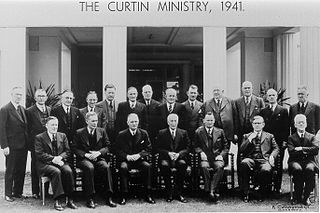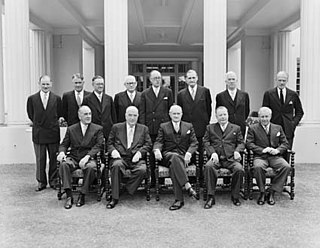
John Curtin was an Australian politician who served as the 14th prime minister of Australia from 1941 until his death in 1945. He led the country for the majority of World War II, including all but the last few weeks of the war in the Pacific. He was the leader of the Australian Labor Party (ALP) from 1935 to 1945, and its longest serving leader until Gough Whitlam.

Francis Michael Forde was an Australian politician who served as prime minister of Australia from 6 to 13 July 1945. He was the deputy leader of the Australian Labor Party (ALP) from 1932 to 1946. He served as prime minister in a caretaker capacity after the death of John Curtin, and is the shortest-serving prime minister in Australia's history.

The Fifth Hughes Ministry (Nationalist) was the 15th ministry of the Government of Australia. It was led by the country's 7th Prime Minister, Billy Hughes. The Fourth Hughes Ministry succeeded the Fourth Hughes Ministry, which dissolved on 3 February 1920 following the federal election that took place in December. The ministry was replaced by the First Bruce Ministry on 9 February 1923 following the 1922 federal election and the subsequent resignation of Hughes as Prime Minister.
The Second Bruce Ministry was the 17th ministry of the Government of Australia. It was led by the country's 8th Prime Minister, Stanley Bruce. The Second Bruce Ministry succeeded the First Bruce Ministry, which dissolved on 18 December 1925 following the federal election that took place in November. The ministry was replaced by the Third Bruce Ministry on 29 November 1928 following the 1928 federal election.

The Scullin Ministry (Labor) was the 19th ministry of the Government of Australia. It was led by the country's 9th Prime Minister, James Scullin. The Scullin Ministry succeeded the Third Bruce Ministry, which dissolved on 22 October 1929 following the federal election that took place on 12 October which saw Labor defeat Stanley Bruce's Nationalist–Country Coalition. The ministry was replaced by the First Lyons Ministry on 6 January 1932 following the federal election that took place in December which saw the United Australia Party defeat Labor. As of 2020, it remains the most recent government to have lost an election after a single term in office.

The Fourth Lyons Ministry was the 23rd ministry of the Government of Australia. It was led by the country's 10th Prime Minister, Joseph Lyons. The Fourth Lyons Ministry succeeded the Third Lyons Ministry, which dissolved on 29 November 1937 following the federal election that took place in October. The ministry was replaced by the Page Ministry on 7 April 1939 following the death of Lyons - the first of three occasions where a sitting Prime Minister died in office.
The Page Ministry was the 24th ministry of the Government of Australia. It was led by the country's 11th Prime Minister, Sir Earle Page. The Page Ministry succeeded the Fourth Lyons Ministry, which dissolved on 7 April 1939 following the death of former Prime Minister Joseph Lyons - the first of three occasions where a sitting Prime Minister died in office. Since Page was the head of the Country Party, it was a caretaker ministry until the senior partner in the Coalition, the United Australia Party, could elect a new leader. Former Attorney-General Robert Menzies was ultimately elected on 18 April 1939. However, due to the Country Party withdrawing from the Coalition after relations between Page and Menzies broke down, Menzies along with his ministry was not sworn in until 26 April 1939.
The First Menzies Ministry was the 25th ministry of the Government of Australia. It was led by the country's 12th Prime Minister, Robert Menzies. The First Menzies Ministry succeeded the Page Ministry, which dissolved on 26 April 1939 following the election of Menzies as UAP leader after the death of former Prime Minister Joseph Lyons. However, due to the Country Party withdrawing from the Coalition after relations between caretaker Prime Minister Sir Earle Page and Menzies broke down, the First Menzies Ministry was composed solely of UAP ministers, and was effectively a minority government. The ministry was replaced by the Second Menzies Ministry on 14 March 1940 after Menzies took the Country Party back into his government - now led by Archie Cameron.
The Third Menzies Ministry was the 27th ministry of the Government of Australia. It was led by the country's 12th Prime Minister, Robert Menzies. The Third Menzies Ministry succeeded the Second Menzies Ministry, which dissolved on 28 October 1940 following the federal election that took place in September. However, as a result of that election the government was reduced to minority status, and were forced to rely on the votes of independent crossbenchers Alexander Wilson and Arthur Coles to survive. The ministry was replaced by the Fadden Ministry on 28 August 1941 following the resignation of Menzies.
The Fadden Ministry was the 28th ministry of the Government of Australia. It was led by the country's 13th Prime Minister, Arthur Fadden. The Fadden Ministry succeeded the Third Menzies Ministry, which dissolved on 28 August 1941 following the resignation of Robert Menzies as Prime Minister. A subsequent joint meeting of the Coalition parties elected Country leader Fadden as Menzies' successor. The ministry was replaced by the First Curtin Ministry on 7 October 1941 after the independent crossbenchers Alexander Wilson and Arthur Coles withdrew their support for the Fadden Government and voted with John Curtin and his Labor Party to bring the government down in a de facto no-confidence motion.

The First Curtin Ministry (Labor) was the 29th ministry of the Government of Australia. It was led by the country's 14th Prime Minister, John Curtin. The First Curtin Ministry succeeded the Fadden Ministry, which dissolved on 7 October 1941 after the independent crossbenchers Alexander Wilson and Arthur Coles withdrew their support for the Fadden Government. The ministry was replaced by the Second Curtin Ministry on 21 September 1943 following the 1943 federal election.
The Forde Ministry (Labor) was the 31st ministry of the Government of Australia. It was led by the country's 15th Prime Minister, Frank Forde. The Forde Ministry succeeded the Second Curtin Ministry, which dissolved on 6 July 1945 following the death of former Prime Minister John Curtin - the second of three occasions where a sitting Prime Minister died in office. Since Forde was the deputy Labor leader, it was a caretaker ministry until the Labor caucus could elect a new leader. Treasurer Ben Chifley was ultimately elected over Forde on 12 July 1945, and he was sworn in as Prime Minister along with his ministry the following day.

The First Chifley Ministry (Labor) was the 32nd ministry of the Government of Australia. It was led by the country's 16th Prime Minister, Ben Chifley. The First Chifley Ministry succeeded the Forde Ministry, which dissolved on 13 July 1945 following the election of Chifley as Labor leader after the death of former Prime Minister John Curtin. The ministry was replaced by the Second Chifley Ministry on 1 November 1946 following the 1946 federal election.

The Fourth Menzies Ministry was the 34th ministry of the Government of Australia. It was led by the country's 12th Prime Minister, Robert Menzies. The Fourth Menzies Ministry succeeded the Second Chifley Ministry, which dissolved on 19 December 1949 following the federal election that took place on 10 December which saw the Coalition defeat Ben Chifley's Labor Party. The ministry was replaced by the Fifth Menzies Ministry on 11 May 1951 following the 1951 federal election.

The Seventh Menzies Ministry was the 37th ministry of the Government of Australia. It was led by the country's 12th Prime Minister, Robert Menzies. The Seventh Menzies Ministry succeeded the Sixth Menzies Ministry, which dissolved on 11 January 1956 following the federal election that took place in the previous December. It is the first ministry to consist of a two-tier ministry, with only senior ministers being members of Cabinet, while the other ministers are in the outer ministry. With the exception of the Whitlam Government and the caretaker First Fraser Ministry, this practice has endured to this day. The ministry was replaced by the Eighth Menzies Ministry on 10 December 1958 following the 1958 federal election.

The McEwen Ministry was the 43rd ministry of the Government of Australia. It was led by the country's 18th Prime Minister, John McEwen. The McEwen Ministry succeeded the Second Holt Ministry, which dissolved on 19 December 1967 following the disappearance of former Prime Minister Harold Holt - the third and most recent occasion where a sitting Prime Minister died in office. Since McEwen was the head of the Country Party, it was a caretaker ministry until the senior partner in the Coalition, the Liberal Party, could elect a new leader. John Gorton was ultimately elected on 9 January 1968, and he was sworn in as Prime Minister along with his ministry the following day.

Although most Australian civilians lived far from the front line, the Australian home front during World War II played a significant role in the Allied victory and led to permanent changes to Australian society.

The Chifley government was the federal executive government of Australia led by Prime Minister Ben Chifley. It was made up of members of the Australian Labor Party in the Australian Parliament from 1945 to 1949.

The Curtin government was the federal executive government of Australia led by Prime Minister John Curtin. It was made up of members of the Australian Labor Party in the Australian Parliament from 1941 to 1945.

The Australian Labor Party held a leadership election on 12 July 1945, following the death of Prime Minister John Curtin. Treasurer Ben Chifley won an absolute majority on the first ballot, defeating three other candidates: deputy leader and interim prime minister Frank Forde, navy minister Norman Makin, and attorney-general H. V. Evatt.


































